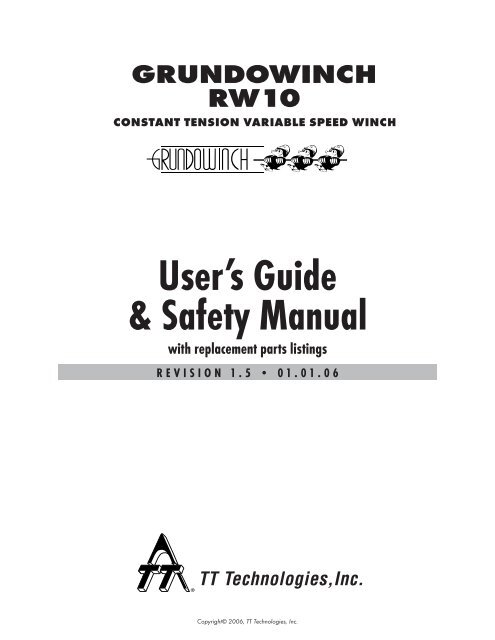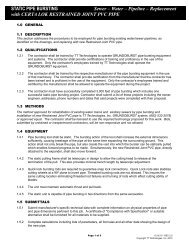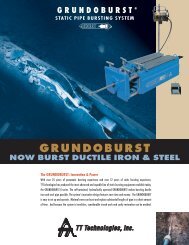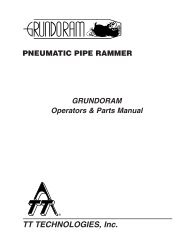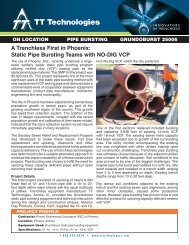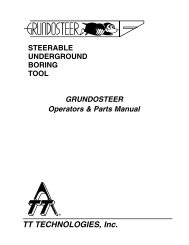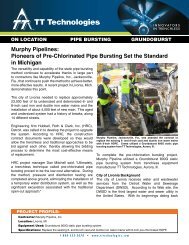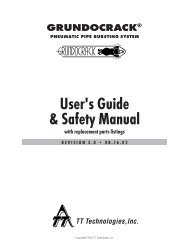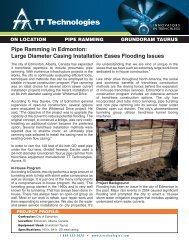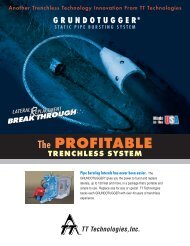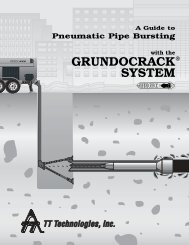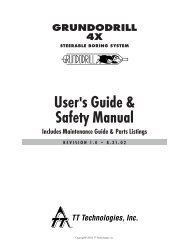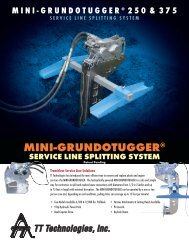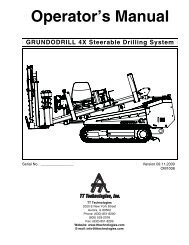Grundowinch Manual (PDF 2.7MB) - TT Technologies Inc.
Grundowinch Manual (PDF 2.7MB) - TT Technologies Inc.
Grundowinch Manual (PDF 2.7MB) - TT Technologies Inc.
- No tags were found...
Create successful ePaper yourself
Turn your PDF publications into a flip-book with our unique Google optimized e-Paper software.
GRUNDOWINCHRW10CONSTANT TENSION VARIABLE SPEED WINCHUser’s Guide& Safety <strong>Manual</strong>with replacement parts listingsR E V I S I O N 1 . 5 • 0 1 . 0 1 . 0 6®<strong>TT</strong> <strong>Technologies</strong>,<strong>Inc</strong>.Copyright© 2006, <strong>TT</strong> <strong>Technologies</strong>, <strong>Inc</strong>.
Table of ContentsSafety Section1.Safety Information about the GRUNDOWINCH. . . . . . .4-7Operations2.General Information. . . . . . . . . . . . . . . . . . . . . . . . . . . . . . . . . . . . . . 8Product Identification . . . . . . . . . . . . . . . . . . . . . . . . . . . . . . . . . . . . . . 8Control Identification. . . . . . . . . . . . . . . . . . . . . . . . . . . . . . . . . . . . . . . 93.Technical Specifications . . . . . . . . . . . . . . . . . . . . . . . . . . . . . . . 10Pulling Force. . . . . . . . . . . . . . . . . . . . . . . . . . . . . . . . . . . . . . . . . . . . 10Winch Line Specs. . . . . . . . . . . . . . . . . . . . . . . . . . . . . . . . . . . . . . . . 10Engine Specs . . . . . . . . . . . . . . . . . . . . . . . . . . . . . . . . . . . . . . . . . . . 10Chassis. . . . . . . . . . . . . . . . . . . . . . . . . . . . . . . . . . . . . . . . . . . . . . . . 10Winch Specs. . . . . . . . . . . . . . . . . . . . . . . . . . . . . . . . . . . . . . . . . . . . 10Twin Capstan Assembly . . . . . . . . . . . . . . . . . . . . . . . . . . . . . . . . . . . 10Winch Line Storage Drum . . . . . . . . . . . . . . . . . . . . . . . . . . . . . . . . . 10Hydraulic System . . . . . . . . . . . . . . . . . . . . . . . . . . . . . . . . . . . . . . . . 104.Safe Operating Procedures. . . . . . . . . . . . . . . . . . . . . . . . . . . . . 11Safety Instructions . . . . . . . . . . . . . . . . . . . . . . . . . . . . . . . . . . . . . . . 11Hydraulic Equipment . . . . . . . . . . . . . . . . . . . . . . . . . . . . . . . . . . . . . 11Rope Inspection, Maintenance . . . . . . . . . . . . . . . . . . . . . . . . . . . . . 115.Transporting The GRUNDOWINCH. . . . . . . . . . . . . . . . . . . . . 11Towing the Winch . . . . . . . . . . . . . . . . . . . . . . . . . . . . . . . . . . . . . . . 11Parking the Winch . . . . . . . . . . . . . . . . . . . . . . . . . . . . . . . . . . . . . . . 12Lifting the Winch . . . . . . . . . . . . . . . . . . . . . . . . . . . . . . . . . . . . . . . . 126.GRUNDOWINCH Setup . . . . . . . . . . . . . . . . . . . . . . . . . . . . . . . . . . 12Winch Placement And Manhole Selection . . . . . . . . . . . . . . . . . . . . . 12Boom Assembly . . . . . . . . . . . . . . . . . . . . . . . . . . . . . . . . . . . . . . . . . 14Before Starting The Winch . . . . . . . . . . . . . . . . . . . . . . . . . . . . . . . . . 14Starting Procedure . . . . . . . . . . . . . . . . . . . . . . . . . . . . . . . . . . . . . . . 14Winch Payout Procedure . . . . . . . . . . . . . . . . . . . . . . . . . . . . . . . . . . 15Winch Line Installation . . . . . . . . . . . . . . . . . . . . . . . . . . . . . . . . . . . . 15Boom Installation . . . . . . . . . . . . . . . . . . . . . . . . . . . . . . . . . . . . . . . . 15Securing Winch Boom Faceplate . . . . . . . . . . . . . . . . . . . . . . . . . . . . 16Stand-Off Legs . . . . . . . . . . . . . . . . . . . . . . . . . . . . . . . . . . . . . . . . . . 16Stabilizing The Winch . . . . . . . . . . . . . . . . . . . . . . . . . . . . . . . . . . . . . 17Propping Up The Winch . . . . . . . . . . . . . . . . . . . . . . . . . . . . . . . . . . . 172 <strong>TT</strong> TECHNOLOGIES, INC.
7.8.9.10.11.12.Operating Instructions - Pipe Bursting. . . . . . . . . . . . . . . . 18Winch Line Placement . . . . . . . . . . . . . . . . . . . . . . . . . . . . . . . . . . . . 18Winch Operation. . . . . . . . . . . . . . . . . . . . . . . . . . . . . . . . . . . . . . . . . 18Removal From The Manhole . . . . . . . . . . . . . . . . . . . . . . . . . . . . . . . 19Maintenance . . . . . . . . . . . . . . . . . . . . . . . . . . . . . . . . . . . . . . . . . . . . . 20Maintenance Checks & Schedule . . . . . . . . . . . . . . . . . . . . . . . . . . . 20Recommended Oil & Lubricants. . . . . . . . . . . . . . . . . . . . . . . . . . . . . 20Troubleshooting Guide . . . . . . . . . . . . . . . . . . . . . . . . . . . . . . . . . . 21Replacement Parts List. . . . . . . . . . . . . . . . . . . . . . . . . . . . . . . . . 23Warranty Information . . . . . . . . . . . . . . . . . . . . . . . . . . . . . . . . . . . 23Appendixes. . . . . . . . . . . . . . . . . . . . . . . . . . . . . . . . . . . . . . . . . . . . . . . 24A. Typical Examples of Wire Rope Deterioration . . . . . . . . . . . . . . . . 24B. Rope/Winch Line Handling. . . . . . . . . . . . . . . . . . . . . . . . . . . . . . . 25C. Adjusting of the Electronic Meter Counter . . . . . . . . . . . . . . . . . . . 29D. Using Battery Charger . . . . . . . . . . . . . . . . . . . . . . . . . . . . . . . . . . 30E. Electric System Wiring Diagram Diesel Engine . . . . . . . . . . . . . . . 31F. Electric System Wiring Diagram Switch Board. . . . . . . . . . . . . . . . 32G. Hydraulic System Diagram . . . . . . . . . . . . . . . . . . . . . . . . . . . . . . 33H. Lighting System Diagram. . . . . . . . . . . . . . . . . . . . . . . . . . . . . . . . 34I. Drawbar Operation & Maintenance . . . . . . . . . . . . . . . . . . . . . . . . . 35Notes. . . . . . . . . . . . . . . . . . . . . . . . . . . . . . . . . . . . . . . . . . . . . . . . . . . . . . 38<strong>TT</strong> TECHNOLOGIES, INC.3
1.Important Safety InstructionsThis symbol calls attention to important safety instructions which, if notfollowed, could result in serious personal injury or death.Read, understand and observe all safety information and instructions in this manual,and on safety decals on the GRUNDOWINCH before using it. For safety reasons, readthe operators manual carefully and exercise caution while using the GRUNDOWINCH.Please note specific safety requirements as explained by procedures called out in thismanual. Failure to follow these instructions could result in serious personal injuryor death.All tools, materials and equipment manufactured and supplied by <strong>TT</strong> <strong>Technologies</strong>, <strong>Inc</strong>.are designed to be used by qualified and trained personnel only. <strong>TT</strong> <strong>Technologies</strong>, <strong>Inc</strong>.will not be held liable for any injury or damage to either people or property resulting fromthe misuse of <strong>TT</strong> <strong>Technologies</strong> equipment.Please save this user's guide for future reference and have it available to alloperating personnel. Personnel should thoroughly read this operating manual.WARNING:WARNING: Crush HazardOpen operation panel to locate safety label.Do not start, operate or service machineuntil you read and understand operator’smanual.Failure to do so could result in serious injury.Do not allow personnel belowequipment while lowering.WARNING: Impact HazardStay clear of front and rear while pulling cable under tension.Equipment may move in either direction suddenly.SAVE THESE INSTRUCTIONS4 <strong>TT</strong> TECHNOLOGIES, INC.
WARNING:WARNING:Moving cable can crush and cut.Do not operate with panel open.Shut off machine before servicing, cleaningand inspecting.Battery explosion can blind.Acid can blind and burn.Read manual before servicing.WARNING:WARNING: Crush HazardFuel and fumes can explode and burn.No smokingNo flameStop engineStay out of the manhole while pullingcable under tension.Boom may shift suddenly.WARNING: Impact HazardWARNING: <strong>Manual</strong>Stay clear of this area while pulling cableunder tension.Operator’s manual is location underengine compartment lid.SAVE THESE INSTRUCTIONS<strong>TT</strong> TECHNOLOGIES, INC.5
Follow all safety instructions concerning safety and possible danger.Do not modify or remove the safety devices or warning labels of this machine. Keep alllabels regarding safety and possible danger on the machine in good, readable condition.Special care is required before and during the safety check.Every crewmember should fully understand the safety measures required for theoperation and should be capable of following these regulations individually.The GRUNDOWINCH is manufactured to the current technical safety-relevantregulations. Nevertheless, the use of the machine may represent a danger to the healthand life of users or third parties. Always ensure that you pay particular attention towarnings, safety labels and instructions.Read Operators <strong>Manual</strong>Before starting the machine, fulfill all safety relatedrequirements. All personnel should thoroughly readthis operating manual.Follow all safety instructions concerning safety andpossible danger. Do not modify or remove the safetydevices or warning labels of this machine. Keep all labelsregarding safety and possible danger on the machine in good, readablecondition. Special care is required before and during the safety check.Every crew member should fully understand the safety measures required forthe operation and should be capable of following these regulations individually.Call Before You DigCheck the existence and exact position of buried pipe and cables bycontacting the respective utilities or owners of networks. The exact anddefinite existence and position of buried cables and pipes should be definedby trial pits or using cable and pipe detection equipment or other means.Cable StrikeShould you accidentally hit an electrical cable, immediately leave the site,ensure no one enters and contact the electrical company to turn off the supply.In case of a cable strike, the danger resulting from that damaged electric cablecan only be evaluated following detailed information by the respectiveelectrical company. Never rely on your own knowledge as to types of cables,safety measures and protective measures that may not be correct for thetype of cable encountered. Always consider cables to be “live” and apotential danger to life. Do not re-enter the site until authorized by theelectrical company.No Loose ClothesDo not wear loose clothes or long hair. Danger of body injury by looseclothes or hair being caught in the moving parts of the machine.SAVE THESE INSTRUCTIONS6 <strong>TT</strong> TECHNOLOGIES, INC.
Personal Protective EquipmentThe operating crew should always wear the appropriate safety equipment,safety shoes/boots, hard hat, safety glasses, gloves, ear protection etc.Operation by Qualified Personnel OnlyOperation of the GRUNDOWINCH should be carried out by suitably trained,qualified, and certified personnel only. New operators or operators intraining should be working under the constant supervision of a qualifiedperson. Personnel operating the GRUNDOWINCH should have sufficientlystudied the operating manual.Skin Burning CautionThis item can be hot or cold. Do not touch as burns may result.GRUNDOWINCH MaintenanceUse the machine only if it is in perfect working order and after studying theoperating manual, particularly the safety-related sections. Always check themachine and its accessories for unwanted movements.To guarantee long life, regular maintenance is essential. Inadequate orinfrequent repair and maintenance operations may lead to accidents,downtimeand costly repairs of the machine.During repair and maintenance operations always follow the respective safetyrecommendations. Repair and maintenance operations are restricted totrained and certified staff only.Transporting the GRUNDOWINCHDanger of accidents. Do not overload the transportation vehicle.Starting & Exit Pit ExcavationMake sure that start and exit pits are excavated and shored as necessary tocomply with OSHA regulations and guard against collapse.DANGER:DANGER indicates an imminently hazardous situation which, if notavoided, will result in death or serious injury. This signal Word shouldbe used in the most extreme situations.WARNING:WARNING indicates a potentially hazardous situation which, if notavoided, could result in death or serious injury.CAUTION:CAUTION indicates a potentially hazardous situation which, if notavoided, may result in minor or moderate injury.SAVE THESE INSTRUCTIONS<strong>TT</strong> TECHNOLOGIES, INC.7
2.General InformationThe RW10 constant tension, variable speed GRUNDOWINCH is a trailer mounted twincapstan mobile hydraulic winch used for a variety of applications including sliplining,pipe bursting and cable placing. The RW 10 is comprised of three major componentsincluding the twin capstan assembly, rope storage drum and the engine/hydraulicpower unit.The winch is mounted on a heavy-duty tandem axle trailer fitted with hydraulic surgebrakes for towing safety. The RW10 is normally fitted with a military type pintle eye andwired for stop and turn signals and night running lights. Storage facilities for the winchmanhole down boom are incorporated, as is wheel chock storage.A. Product IdentificationRecord Identification NumbersIf you need to contact <strong>TT</strong> <strong>Technologies</strong> for information on servicing, always provide themodel and serial numbers.You will need to locate the Identification numbers for the machine. Record theinformation in the spaces provided below.Machine Identification NumbersModel #__________________Serial # __________________Engine Identification NumbersModel #__________________Serial # __________________8 <strong>TT</strong> TECHNOLOGIES, INC.
B. Control Identification1 2 3 5 6 7 842018172316 15 14 13FIG. 1: GRUNDOWINCH CONTROLS910NUMBER DESCRIPTION1 Battery2 Engine oil3 Air filter (when light is on filter needs service)4 Low fuel (when light is on indicates low fuel)5 Hour meter6 Operation control indicator light (GREEN)7A & 7B Control panel fuse & cooling fan fuse8 System pressure/Tonnage gauge9 Remote socket10 Emergency - Stop11 Tonnage selector12 Speed/Range selector (5 ton/10 ton)13 Line speed control14 Rope pull out (green)15 Stop (red)16 Rope pull in (black)17 12V Power socket18 Starter button19 Engine throttle lever20 Ignition switch21 Auxiliary hydraulic outlet selector (optional)22 Auxiliary hydraulic coupler (optional)23 Digital line counter (see appendix C for operation)1922211211FIG. 1A: GRUNDOWINCH CONTROLSFIG. 1B: WINCH LINE REMOTE<strong>TT</strong> TECHNOLOGIES, INC.9
3.Technical SpecificationsA. Pulling ForceWinch TypeRW10Pulling Force10 Ton (10,000 kg)Pulling Speed @ 10 Ton 0-46 ft./min / (0-14 m/min)Pulling Speed @ 5 Ton 0-92 ft./min / (0-28 m/min)Pulling Speed Max 46-92 ft./min / (12.8-28 m/min)Pulling-out Speed 46-92 ft./min / (12.8-28 m/min)B. Winch Line SpecsLine Diameter5/8-in. (16 mm)Line Length 2,300 ft. (701 m)C. Engine SpecsEnginePowerD. ChassisTypeHeightHitchWeight CapacityCoupling HeightTiresE. Winch SpecsLengthWidthHeightWeight (without boom)2-cylinder diesel35 H.P. (26 kW)TandemAdjustablePintle Eye6,600 lbs. (2,993.7 kg)16-in. to 43-in. (406.4 mm to 1,092.2 mm)205/70 R14181 in. (4,497.4 mm)72 in. (1,828.8 mm)58 in. (1,473.2 mm)6,500 lbs. (2,948.4 kg)F. Twin Capstan AssemblyThe capstans are of equal diameter and are driven by two hydraulic motors. Unlikewinches that pull off the drum, the hydraulic system of the GRUNDOWINCH ensures fullpower output regardless of storage drum back tension. The line pull is regulatedautomatically, giving very smooth operation without jerking or slack. The capstan andassociated parts are machined from low wear, case hardened steel and include rollerbearings. The capstans are machined to accept 5/8" (16 mm) winch line.G. Winch Line Storage DrumThe RW10 winch line storage drum is independent of the winch and is driven by aseparate hydraulic motor. A cross groove spindle-layering device ensures precision ropelayering on the drum during operations, preventing winch line damage. Capacity isapproximately 2,300 feet (701 m).H. Hydraulic SystemThe hydraulic power system is comprised of a 35 H.P. (26 kW) two-cylinder engine,hydraulic pump and motors to operate capstan and rope storage drum. A separatehydraulic reservoir and oil cooler allow for continuous operation with no overheating.The system provides fully automatic winching control.Hydraulic power is generated by a pressure and flow controlled axial piston pump that isdriven by the two-cylinder diesel engine. The hydraulic flow from the pump determinesthe line speed that is infinitely variable by a hand wheel throttle valve. All RW10winches are equipped with a selector for two speed/tonnage settings (0:10) + (0.5).In both settings the speed and tonnage can be varied from 0 to max - the max linespeed is twice and the max tonnage is half in the 0-5 ton setting compound to the0.10-ton setting.10 <strong>TT</strong> TECHNOLOGIES, INC.
Safe Operating ProceduresA. Safety InstructionsFor your protection and the protection of others, practice the following safety rules.1. Read operators manual and safety decals before operating this winch.2. Only authorized personnel familiar with this winch and its functions to operate.3. Do not use to lift, support or transport personnel.4. ONLY pull load in horizontal direction. Do not use to lower or pullequipment vertically.5. Do not operatue until all safety shields are in place and controlsfunction properly.6. Turn off engine and secure against accidental movement and/or unauthorizedstart-up if leaving winch unattended.7. Keep winch clear of motor vehicle traffic or provide barriers, signs and/orwarning lights.8. Verify all safety shields are refitted after maintenance.9. Provide a quality inspection by a qualified specialist at least once a year.10. Shut off winch and wait for movement to stop before,servicing, cleaning or inspecting.11. Only authorized operations personnel to remain nearequipment while cable is pulled under load.12. NEVER enter manhole or excavation pit while winch ispulling cable under load.13. Personal protective equipment is required while operatingthis machine. Keep hands, feet and clothing away frompower-driven parts.4.B. Hydraulic Equipment1. Tighten all connections before applying pressure.Relieve pressure when service unit.2. Check for leaks with a piece of cardboard. Do not use hands.3. Do not exceed working pressure of hydraulic hoses.4. Visually inspect hydraulic system and connections regularly. Service if neededC. Rope Inspection, Maintenance(See Appendix A, B)Open operation panel tolocate Safety Instructions.Transporting TheGRUNDOWINCHA. Towing the WinchThe RW10 has an adjustable hitch arm to allow the winch to be towed by vehicles withvarious height rear bumpers. By adjusting the two pivot points, the tandem tires willsupport the load at a level attitude at most vehicle hitch levels.1. To change the winch attitude, lower the front jack stand to support the front ofthe winch and provide a level winch attitude. Loosen the lock levels on each ofthe winch pivot points.2. Raise or lower the hitch to the proper tow vehicle hitch height.3. Tighten the lock levels and replace the safety pins prior to towing the winch.IMPORTANT: Winch must be level for safe highway towing.4. Secure the military type locking pintle hitch on the tow vehicle to the RW10pintle eye. The hitch must be securely mounted. Full range jack to prevent fromhitting any obstacles.5.<strong>TT</strong> TECHNOLOGIES, INC.11
5. Check the mounting bolts regularly for tightness.6. Connect the two high strength safety chains to the tow vehicle frame,independent from the vehicle hitch.7. Connect winch lights/electrical system to towing vehicle. Check that lights arefunctioning correctly.8. Connect emergency break-away brake actuator.9. Check all accessories on winch that they are properly placed and secured.10. After winch is properly secured to tow vehicle check that the manual brake isreleased before towing.CAUTION: The RW10 weighs in excess of 6,000 lbs (2,721.6 kg). The towvehicle must be rated for this load.A trailer connection light cable is provided to transfer lighting and signals to thewinch. Check all lights for proper operation prior to towing. Due to the weightof the RW 10, limit operations to normal highway speeds and be aware ofincreased stopping distances with the winch attached. Rain, ice and snow willhave a detrimental effect on safe highway operations.B. Parking the WinchOn level ground simply apply the parking brake of the winch before uncoupling it fromthe towing vehicle.In down-hill position apply the parking brake of the winch and put the chocks (held onthe side of the winch) in front of both wheels.In up-hill position allow the towing vehicle to roll back far enough to let the brake systemengage into reverse mode, apply parking brake and put the chocks behind both wheels.C. Lifting the WinchFor lifting the winch by crane, use the two lifting eyes on top of the winch. Use a liftingbeam to ensure that the lifting eyes are stressed only vertically.6.GRUNDOWINCH SetupThe majority of winch operations using the RW10 involve either a manhole or trench box(excavation). The following setup will describe a typical pipe bursting situation.A. Winch Placement and Manhole SelectionA pre survey of the site conditions will help the operator determine which manhole to setthe winch, what position around the manhole to set the winch; and depth of manhole willdetermine the length of the boom.An ideal winch placement includes adequate space for HDPE and equipment staging,minimal disruption to the surrounding area and a properly sized manhole in goodcondition (see Fig. 2).12 <strong>TT</strong> TECHNOLOGIES, INC.
GRUNDOWINCH ®CompressorExitPitGRUNDOCRACK ®Entry PitOld PipeWinch LineRear ExpanderNewPE PipeFIG. 2: MANHOLE SELECTION FOR GRUNDOWINCH PLACEMENTIn a pipe bursting application the receiving manhole or winch manhole selection isbased on several factors including the following.1. HDPE STAGINGAdequate space is needed to safely and properly stage the fused length of HDPEprior to bursting. Avoiding public inconvenience or disruption such as blockeddriveways or business entrances may require switching manhole choice.2. OBSTACLESAny obstacles adjacent to the selected manhole such as street lights, trees,damaged walls, landscaping, etc. and ground conditions such as mud, water,decorative stone, peripheral utilities, etc. will affect where and how the winch canbe set up.3. MANHOLE CONSTRUCTION OR CONDITIONOffset inverts and chimneys, damaged walls and loose bricks may make themanhole unusable.4. FLOW DIRECTIONPipe bursting with the flow (if bypass pumping is a problem) is desirable, so thewinch manhole selection may be indicated by flow direction.5. MANHOLE AND EXPANDER SIZESReversible GRUNDOCRACK tools utilize front or head expanders. Once the toolreaches the destination manhole, it is reversed out of the newly installed HDPE.The manhole diameter must be large enough to accept the front expander.After the winch is in position over the manhole, pull the parking brake into theON position. Place wheel chocks under tires on both sides of the winch anddisconnect the tow vehicle.NOTE: Cones, barricades, etc., should be placed around the winch in a trafficsituation. A minimum 10-ft. (3 m) working radius around the winch is desired toprevent traffic problems.<strong>TT</strong> TECHNOLOGIES, INC.13
B. Boom AssemblyThe RW10 boom has a swivel assembly allowing the winch to be placed in any positionaround 360 degrees. This feature allows movement of the winch around the manholedue to structure, traffic or ground conditions.1. Determine the distance from the winch/boom attachment point down to theinvert or pipe level in the manhole. Using a tape measure, measure from theinvert or pipe bottom up to the mounting points.2. Extend the main boom sections (upper and lower) to index a set of holes ineach unit.3. Secure the two boom sections together at the proper length using a fixingclamp. An extension may need to be added (3' or 6') (.9 m or 1.8 m) to read theproper length - refer to the following information for approximate lengths usingsupplied extensions.Boom only-Closed - 5'2" or 62" (1,574.8 mm)Open - 7'2" or 86" (2,184.4 mm)Boom with 3-ft. (.9 m) extensionFirst hole - 8'2" or 98" (2,489.2 mm)Last hole - 10' 1 1/2"or 121 1/2" (3,086.1 mm)Boom with 6-ft extension (1.8 m)First hole - 11' 1" or 133" (3,378.2 mm)Last hole - 13'1" or 156" (3,962.4 mm)Boom with both 3-ft and6-ft (.9 m and 1.8 m) extensionsFirst hole - 14'1" or 169" (4,292.6 mm)Last hole - 16' 1/2" or 192 1/2" (4,889.5 mm)NOTE: Winch output pulley/mounting points can be raised or lowered to “finetune” the boom adjustment. Use the front jack and/or rear propping beams forminor adjustments. These adjustments are best left until the down boom is placedon the manhole.C. Before Starting the WinchCheck to see if it is safe around the winch before starting.Check low fuel indicator light when ignition switch is on, if necessary fillwith diesel fuel as required.Check motor oil and hydraulic oil levels and fill as needed. (For type of oils to beused check Technical Specifications.)Make sure all covers and shields are closed and secured, before start-up.(Except for winch controls cover.)Caution: Do not run the winch in closed or poorly vented areas.D. Starting ProcedureMove the tonnage selector to the neutral position (0).Swivel Top SectionIntermediate SectionFIG. 2A: TYPICAL 10-TON SWIVELBOOM ASSEMBLYTurn line speed control hand wheel clockwise to its lowest output position. (Turtle)Make sure either the remote control or blind plug is connected to theremote socket.Set the engine throttle lever to a middle position. (Engine throttle level has anautomatic shut down in the far right position.)Turn the ignition swich to the on position.SheaveFaceplate14 <strong>TT</strong> TECHNOLOGIES, INC.
Push in starter button to start engine. (Notice: do not press starter button forlonger than 20 seconds. If winch did not start allow starter to cool beforeattempting to start again.)Allow engine and hydraulic oil to warm before operating any functions.Cold Starting ProcedureIn cold weather the engince and hydraulic oil need a longer warm up time, allow atleast 5-10 minutes at half throttle before operating any functions.NOTICE: Never use any spray starting additives, damage to the enginecould occur.E. Winch Payout ProcedureWith engine running using the throttle lever increase engine speed to a 3/4 throttle.Push the stop button on the winch or remote if attached. (Note: This is not theemergency stop button.)Move tonnage selector to a middle position.Turn line speed control handle counterclockwise to its highest outputposition. (Rabbit)Pull winch line out as needed.NOTICE: Move range selector to reach desirable payout.F. Winch Line InstallationAfter the boom is extended to the proper length, the winch rope must be pulled outand inserted through the tops of the boom, down through the boom, with the eyeexiting the lower winch pulley.IMPORTANT: The two wire rope containment bolts and nuts must be removed toallow the winch rope eye to pass through and out the boom bottom prior tostartingthe winch.G. Boom InstallationAfter the winch rope is installed in the assembled boom lower boom into themanhole (see Fig. 3).CAUTION: The assembled boom, especially with extensions installed, is tooheavy for manual placement. The use of a backhoe to place the boom isrecommended to avoid injury.Boom faceplates need to be properlyaligned with the host pipe andadequately supported and blocked toprevent damage to the boom andensure trouble-free winching operations.1. Secure lifting strap to the boom andbackhoe, fitting the connecting earsof the boom swivel top into the studsat the output pulley and securing theholding pins.2. Carefully lower the boom into place.3. Check the lower faceplates of theboom for proper alignment with thepipe. Adjust if necessary.GRUNDOWINCH ®ExitPitBoom Loweredinto placeOld PipeFIG. 3: GRUNDOWINCH BOOMPLACEMENTCAUTIONCompressorHeavy Object.Lifting may causepersonal injury.Use lifting device wheninstalling or removingfor servicing.Entry Pit<strong>TT</strong> TECHNOLOGIES, INC.15
NOTICEH. Securing Winch Boom FaceplateThe RW10 boom is designed to pull against a solid object (manhole wall/trench boxspreader or steel/wood timber blocking). If no support is provided for the faceplate ofthe boom, the boom could bend, possibly enough to make disassembly difficult andmake the boom unstable. As tension is applied, the faceplate will be pulled against thetimber or manhole wall, becoming tight and secure (see Fig. 4).The lower section of the boom must be properly braced. If the faceplate is larger thanthe pipe opening, no additional bracing is necessary.NOTICE: Without support for the faceplate, the boom will bend at theblocking. The damage to the boom may be un-repairable.BoomFaceplateGRUNDOWINCH ®SheaveBlockManhole WallOld PipeWinch LineCompressorGRUNDOCRACK ®Rear ExpanderAdjustable LegsEntry PitTimbersManhole WallOld PipeNewPE PipeWinch LineFaceplateFIG. 4: SECURING WINCH BOOMFACEPLATEFIG. 4A: TOP VIEWSTAND-OFF LEGSI. Stand-Off LegsSome winching operations require the boom to be placed back from the manhole entryto allow the product pipe to enter the manhole. Some RW10 booms have adjustableleg attachments built in, which are assembled after the boom is placed in the manhole(see Fig. 4A). Others have an add-on plate and leg assembly that is bolted to the lowerboom faceplate. In addition, timbers can be used to accomplish moving the boom to thefar side of the manhole.NOTICENOTICE: When using legs or timbers against the manhole wall, theuse of wood 2x10 or 2x12 pads are necessary to spread the load of thelegs to prevent driving the legs through the manhole wall during thepulling operation.16 <strong>TT</strong> TECHNOLOGIES, INC.
J. Stabilizing the WinchThe RW10 has two Front Stabilizers and two Rear Propping Legs in addition to theFront Jack Stand. This allows leveling both laterally and side to side. In most situations,this is done after the winch boom is in position.1. Set the rear propping legs by pulling the fixing pins and dropping the legs.2. Raise or lower the winch to level by pulling the faxing jack and re-installingthe pins.3. The rear propping legs are adjustable to provide proper clearance. Remove thefirst pin and slide the propping leg assemble out.CAUTION: Never extend the leg past the last locating hole, as theentire leg assembly will fall from its socket.4. Position the front legs in the same manner as the rear. Raise or lower thewinch to index a locating hole.NOTE: If the winch is positioned on uneven ground, use the propping bar toraise one side and level the winch.565234411FIG. 5: REMOVE FIXING PINFIG. 6: PULL OUT PROPPING BEAMK. Propping up the Winch (see Fig. 5, 6 & 7).1. Remove fixing pin (1) from horizontal propping beam (2).2. Pull out horizontal propping beam (2)as far as required.3. Re-insert fixing pin (1) when bores arein line and secure in place (3).4. Remove the fixing pin (4) of prop (5),holding it to prevent it from falling.5. Let prop (5) slip down to the ground.6. Insert jacking-up wrench (6) with itsfront pin into the pivoting bore and itssecond pin into the upper prop bore.7. Press wrench (6) down until fitting pin(4) fits into next upper bore.8. Insert fixing pin (4) and removejacking-up wrench (6).9. Secure fixing pin (4) in place.65FIG. 7: USE JACKING-UP WRENCH42<strong>TT</strong> TECHNOLOGIES, INC.17
7.WARNINGWARNINGOperating Instructions—Pipe BurstingA. Winch Line Placement1. Set winch in position over manhole as described in section 6A.2. Secure winch brake, chock wheels, and set prop legs.3. Install wire rope through boom as described in section 6C-E, extend boom toproper length and secure fixing clamps.4. Install an Aramid fiber pull tape (with an elongation tensile of less than 5%)through the host pipe prior to the pipe burst. This step can be accomplishedwhen the host pipe is jet cleaned or when the host pipe is video taped prior tothe burst. The use of Jam skid corner sheaves may be required to preventdamage to the pull tape. The pull tape must be strong enough to pull the weightof the entire length of winch cable being pulled into the host pipe. The 5/8"cable, for the 10 ton GRUNDOWINCH, weighs 0.72 lbs. per foot and the 7/8"cable, for the 20 ton GRUNDOWINCH, weighs 1.42 lbs. per foot.WARNING: Use of any alternate pull in method or pull in tape, to install thewinch line, could result in death or serious injury and is not recommendedby <strong>TT</strong> <strong>Technologies</strong>.5. Attach pull tape to winch line.6. The winch line can be pulled from the winch, through the boom, and into thehost pipe. Continue pulling the tape until the winch line arrives at the entrancepit, make sure enough excess winch line is available to connect the winch line tothe assembled pipe bursting unit.WARNING: Pull tape only as fast as the winch cable payout will allow,pulling faster than cable payout could over stretch/tension the tape to thepoint of breaking. All personnel must remain clear while pulling tape toinstall winch cable. Failure to follow this warning could result in death orserious injury.B. Winch OperationAfter the following preliminary steps are completed, the GRUNDOWINCH offers almostautomatic operation. In most situations, no adjustments to the throttle or pull force willbe necessary once bursting is underway. The RW10 automatically maintains tonnageand speed to keep up with the GRUNDOCRACK’s bursting speed.IMPORTANT: Fluid levels should be checked and, if needed, replenished prior tostarting a burst.1. To start, shift the tonnage/pull selector to the desired range. The 0 to 5 t side isnormally used for smaller diameter bursting operations 4", 6" (102, 152.4 mm) orshort pulls. The 0 to 10t side is normally used for all other operations.2. Set the tonnage selector to 0.3. Push the pull-in button to set winch in retrieval mode.4. <strong>Inc</strong>rease the throttle to fast (3/4 full).5. Slowly move the tonnage selector up and watch as the rope starts to pull in.The force required to move the GRUNDOCRACK into position will dependonthe terrain conditions, length of fused HDPE, diameter and thickness ofpipe. Continue to pull the GRUNDOCRACK into position, increasing the pullas needed.18 <strong>TT</strong> TECHNOLOGIES, INC.
IMPORTANT: Good radio communications are a necessity as coordinationbetween the winch, air compressor and entrance pit personnel is essential.NOTE: In some cases, the GRUNDOCRACK unit can be helped along by amachine, (backhoe, trackhoe, dozer, etc.) to reduce the strain on the winch.6. Pull the GRUNDOCRACK unit down the entrance pit and guide the nose of thehammer into the host pipe. Check the integrity of the boom bracing. Adjust ifnecessary.7. The winch pull should be maintained at the tonnage required to “set” theGRUNDOCRACK in position, and the GRUNDOCRACK can be started.NOTE: The GRUNDOCRACK’s bursting speed will be primarily determined by itsability to crack the pipe, expand the soil, and overcome the resistance of the newpipe as it is pulled through with the RW10 assisting all the above functions.IMPORTANT: <strong>Inc</strong>reasing the pull of the winch will not, in all cases, increase thespeed of the burst. Every burst is different and coordination of the winch and theGRUNDOCRACK provide the best burst speed.8. Continue the bursting operation until the entire new pipe is installed and theGRUNDOCRACK reaches the winch manhole.CAUTION: Do not leave winch unattended during bursting operations.The winch must be manned at all times to provide a safe operation.IMPORTANT: The RW 10 should always continue to maintain pull until theGRUNDOCRACK is shut down to prevent the nose of the GRUNDOCRACKrunning over and damaging the winch cable.CAUTIONC. Removal From The ManholeAs the GRUNDOCRACK approaches the exit manhole, communications with thecompressor crew is vital to stop the airflow as the nose of the hammer enters themanhole. Damage to the downboom and manhole can occur if the GRUNDOCRACK isallowed to run too long.1. As the cable eye enters the manhole, slowly lower the tonnage selector to 0 pull.Close the air compressor valve and open the air relief valve. This helps stop theGRUNDOCRACK.NOTE: The expander of the reversible GRUNDOCRACK should enter theprepared manhole far enough to provide for the new product pipe in the manhole.2. Remove the connection bolt/pin from the GRUNDOCRACK and disconnect thewinch rope.3. Remove the boom from the manhole.4. Store the propping legs and wheel chocks. Release the parking brake andremove the winch from the manhole area.<strong>TT</strong> TECHNOLOGIES, INC.19
8.MaintenanceThe GRUNDOWINCH requires a minimum amount of maintenance. However, specificmaintenance checks and inspections should be carried out on a regular basis in order toensure trouble free operation. (Reference Hatz Engine <strong>Manual</strong>)A. Maintenance Checks & Schedule1. Regularly lubricate all grease points according to the lubrication chart(see Fig.8 & 8A).2. Check hydraulic fluid levels. Replenish if needed.3. Check hydraulic system including hoses and screw connections for leaks.4. Check engine oil level. Replenish if needed.5. Check tire pressure. Inflate if needed.6. Check overrun braking system.FIG. 8A: LUBRICATION CHARTFIG. 8: LUBRICATION AREAB. Recommended Oil & LubricantsHydraulic OilDexron III ATFEngine Oil 10W-40Gear Box Oil SAE 90GreaseMulti-purpose20 <strong>TT</strong> TECHNOLOGIES, INC.
Troubleshooting Guide9.Observation Reason Solution1. Line pull indicator andpreselector differ widely.2. At stage 2 winch pulls normallybut at stage 1 full line pull isnot reached.3. Winch stops at low line pull andline speed.4. Winch stops althoughpreselection lever is set torange 2.5. Rope can not be pulled in or out.No hydraulic pressure onthe gauge.Green control lamp on panelboard is out.Capstans do not revolve.a) Bowden cable has becomeloose or out of adjustment.a) 3-way ball valve defective:leakage between ball andhousing; test by disconnectingpipe at ball cock; if ball liesloose in the housing, then ballcock is defective.b) One of the capstan motors isdefective: oil leakage due tomechanical failure; test bymeasuring leakage oil.Disconnect leakage lineon upper then lower motorand close line to tank withplug;connect hose to leakage oilsocket and hold it into acontainer. Start winch and pullrope in under load; leakage oilflow should not exceed 0.5 l/min.a) Resistance in oil flow to capstanmotors is too low.a) Resistance in oil flow to capstanmotors too lowa) “Emergency-stop” button hasbeen pressedb) Remote control socket isunpluggedc) Poor contact of electrical wiresd) Coupling has become loosenand is off the pummp shafte) Pivot pin of the pump will not bepushed by the bowden cable ofthe line-pull selectionf) Pump control unit defecta) Turn setting screw of Bowdencable to exact position as perline pull indicator.a) Replace ball valve.b) Replace capstan motor.a) At low line pull and line speedpreselection lever should be instage 1.a) Readjust resistance valve; takeoff cap nut (wrench 22) and turnsocket screw 1 or 2 turns intohousing.a) Engage “emergency-stop” buttonb) Put remote control or dummyplug to the socketc) Fit the cables of the solenoidvalve directly to the batteryd) Refit the pump from theIC-engine, replace the couplingand secure ite) Adjust bowden cable as perinstructionf) Replace pump<strong>TT</strong> TECHNOLOGIES, INC.21
Observation Reason Solution6. Rope does not pull out.a) Controls are not properly set.a) Set controls as per operatinginstructions.7. Rope pulls out very slow.a) Engine speed is too low.a) <strong>Inc</strong>rease engine speed.b) Line speed control not atmaximum.b) Set line speed control tomaximum.c) Line pull selection lever atstage 1 or set too low.c) Set line pull selection lever tostage 2.8. Rope drum overruns when ropeis pulled out.a) Brake pressure is too low.a) <strong>Inc</strong>rease brake pressure atbrake pressure valve.9. Winch does not pull(capstans turning).a) Controls not properly set.a) Set controls as per operatinginstructions.b) Rope drum blocked by foreignobject.b) Remove foreign object that mayblock or brake rope drum.c) Driving chain broke.c) Replace chain.d) Oil motor has no advance.d) <strong>Inc</strong>rease advance at theresistance valve.e) Oil motor of rope drum defective.e) Replace oil motor.10. Winch does not develop fullline pull.a) Rope slips on capstans, oilpressure on rope drum motor istoo low.a) <strong>Inc</strong>rease pressure at pressurereduction valve - preselector.b) Pump defect.b) Replace pump.11. IC engine stalls.a) Line speed setting is too high.a) First set line speed to zero andincrease slowly in proportionwith pull line.b) Hydraulic pump defective.b) Replace pump.12. Winch does not pull, oilpressure increases.a) Rope twisted on capstans,capstans covering is worn out.a) Repair or replace capstancovering.b) Oil motor of capstans isdefective.b) Repair or replace oil motor.22 <strong>TT</strong> TECHNOLOGIES, INC.
Replacement Parts ListDescriptionPart NumberEngine Oil Filter 40065300Engine Air Filter 00952900Fuel FilterH50251500Inline Pre-Fuel Filter 40089401Hydraulic Oil Filter 104.078.0010.Warranty InformationDISCLAIMER FOR GRUNDOWINCH MANUAL:NO WARRANTY AS TO MANUAL<strong>TT</strong> <strong>Technologies</strong> makes no warranty that the information provided in this manual iscomplete, accurate in all respects, or up to date. This manual should be used as areference work to provide a starting point for addressing GRUNDOWINCH situations.Each particular situation is different. The user is responsible for providing the expertiseand skill necessary to properly execute a given job. <strong>TT</strong> <strong>Technologies</strong> specificallydisclaims all express or implied warranties concerning this manual, including the impliedwarranties of merchantability and fitness. In no event shall <strong>TT</strong> <strong>Technologies</strong> be liable forconsequential, special or incidental damages or contingent liabilities (including, withoutlimitation, lost profits or goodwill, whether such claim arises in tort, contract, negligence,strict liability or any other basis) arising in any way out of the use of this manual.11.LIMITED WARRANTY AS TO PRODUCTS<strong>TT</strong> provides a limited warranty to the original purchaser of its new products that newproducts will be free from defects in materials and workmanship for 90 days or 500hours of actual use, whichever occurs first, provided they are properly maintainedserviced and used for the intended purpose of the product. During the 90 day or 500hours period, buyer's remedies are limited to repair or replacement, at <strong>TT</strong> <strong>Technologies</strong>'discretion.<strong>TT</strong> <strong>Technologies</strong> makes no other warranty, express or implied, and makes no warranty ofmerchantability or fitness for any particular purpose. No person, representative or agentof <strong>TT</strong> <strong>Technologies</strong> has the authority to change this warranty in any mannerwhatsoever. Any oral or written statements inconsistent with this limited warranty shallnot apply.In no event shall <strong>TT</strong> <strong>Technologies</strong> be liable for consequential, special or incidentaldamages or contingent liabilities (including, without limitation, lost profits or goodwill,whether such claim arises in tort, contract, negligence, strict liability or any other basis)arising in any way out of the use of any product or any parts thereof.<strong>TT</strong> TECHNOLOGIES, INC.23
Appendix A. Typical Examplesof Wire Rope Deterioration12.1. Mechanicaldamage due torope movementover sharp edgeprojection whileunder load.9. Typical wirefractures as aresult of bendfatigue.2. Localized weardue to abresaionon supportingstructure.10. Wire fracturesat the strand, orcore interface,as distinct from‘crown’ fractures.3. Narrow path ofwear resulting infatigue fractures,caused byworking in agrossly oversizegroove, or oversmall supportrollers.11. Break up ofIWRC resultingfrom high stressapplication.4. Two parallelpaths of brokenwires indicative ofbending throughan undersizegroove in thesheave.12. Looped wiresas a resultof torsionalimbalance and/orshuck loading.5. Severe wear,associatedwith high treadpressure.13. Typical exampleof localized wearand deformation.6. Severe wearin Langs Lay,caused byabrasion.14. Multi strandrope ‘bird caged’due to torsionalimbalance.7. Severe corrosion.15. Protursion ofrope centerresulting frombuild up of turn.8. Internal corrosionwhile externalsurface showslittle evidence ofdeterioration.16. Substantial wearand severeinternal corrosion24 <strong>TT</strong> TECHNOLOGIES, INC.
Appendix B.Rope/Winch Line HandlingA. Flemish Eye-Splice or "Molly Hogan"One of the simplest and quickest eye splices for both field use and in the shop is theFlemish Eye-Splice or "Molly Hogan" - sometimes referred to as the "Rolled In" eyesplice. This is especially applicable to preformed wire rope.1. Bind the rope from the end at a distance equal to the length of loop desired -plus an additional lenth of approximately ten times the rope diameter. Split therope by separating three adjacent strands, leaving the other three strands andcore intact (see Fig. 9).2. Bend the sets of strands into the desired size loop, crossing over with one setin the same manner you would make a simple overhand knot. The two sets ofstrands will "lock" together (see Fig. 10).3. Start laying the strand selections alternately back into the rope grooves,continuing until the sections are laid as deep into the throat as possible,allowing the six strands and core to project past the oval of the loop(see Fig. 11).4. Cut the core, if it is a fiber core rope. At this point you may:A) Apply a compression type fitting (see Fig. 12) orB) Hand tuck ends.FIG. 9: SPLIT THE ROPEFIG. 10: MAKE DESIRED LOOPFIG. 11: ALTERNATE STRANDSFIG. 12: APPLY COMPRESSIONFI<strong>TT</strong>ING<strong>TT</strong> TECHNOLOGIES, INC.25
B. Rope Handling1. <strong>Inc</strong>orrect uncoiling/unreeling of wire rope will cause stresses in the lay of the ropeand may eventually affect its structure. Kinks may develop which will make ropehandling more difficult (see Figs. 13 & 14).FIG. 13: INCORRECT WAYFIG. 14: CORRECT WAY2. Do not pull the rope over fixed objects or edges to prevent the strands fromuntwisting (see Fig. 15).3. Always adjust rope pulleys in line with the pulling direction! Max deflection angle4° (see Fig. 16).FIG. 15: DO NOT PULL OVERFIXED OBJECTSFIG. 16: ADJUST ROPE PULLEY4. Do not pull rope clamps over sharp angles or narrow bends to avoid tearing ropestrands out of the pressing (see Figs.17 & 18).Sharp AngleFlat AngleFIG. 17: INCORRECT WAYFIG. 18: CORRECT WAY26 <strong>TT</strong> TECHNOLOGIES, INC.
5. Rope loops should be laid around circular fittings to prevent sharp bending andeventually breakage of the single wires in the strand (see Figs. 19 & 20).FIG. 19: INCORRECT WAYFIG. 20: CORRECT WAY6. Rotating tools (such as duct brushes) should be connected to the rope with aswivel joint in between. Make sure the rotating tool connected to the rope (via theswivel joint) tends to twist the rope tighter, i.e. the direction of the rotationcorresponds to the lay of the pulling rope (see Fig. 21).RIGHT-LAY WINDED ROPE SWIVEL JOINT LEFT-SPIRALLED BRUSHFIG. 21: CORRECT WAYA rotation of the tool against the direction of the lay of the pulling rope will tendto untwist the rope strands in spite of the swivel joint and thus impair the tensilestrength of the rope (see Fig. 22).RIGHT-LAY WINDED ROPE SWIVEL JOINT RIGHT-SPIRALLED BRUSHFIG. 22: INCORRECT WAY<strong>TT</strong> TECHNOLOGIES, INC.27
However, every rotating tool will tend to transmit a slight twist to the rope, evenwhen the use of a good swivelling joint and a tool whose rotation correspondsto the lay of the rope strands. Hence, the rope may develop small loops whichshould be untwisted by hand before the rope is pulled in, but shrink into kinkswhich, when passed forcibly through narrow passages (guided pulley etc.), maydamage the rope badly (see Fig. 23).FIG. 23: INCORRECT WAY7. Always adjust pulleys in line with the direction of pull. Max. deflection angle 4°(see Figs. 24, 25 & 26). The diameter of external pulleys should not be smallerthan that of the tail pulley of the winch.FIG. 24: ADJUST ROPE PULLEYFIG. 25: ADJUST ROPE PULLEYFIG. 26: ADJUST ROPE PULLEY28 <strong>TT</strong> TECHNOLOGIES, INC.
Appendix C. Adjusting of theElectronic Meter Counter1st StepPush the program button2nd StepIn the display appears: “COUNT HR TIMER”Push the reset button until “COUNT”is in a flashing modePush the program button3rd Step“COUNT” is in a flashing modePush the reset button three times.In the display appears “0003”Push the program button4th Step“COUNT” is in a flashing modeIn the Display appears “0003”Push the program button four times5th Step“COUNT” is in a flashing modeIn the display appears “0”Push the program button“COUNT” stops flashing. The gauge is setinto feet counter modus.<strong>TT</strong> TECHNOLOGIES, INC.29
Appendix D.Using Battery ChargerBattery gas is explosive:DO NOT smoke while you charge battery.Keep all flames and sparks away.DO NOT charge frozen battery or low on electrolyteDO NOT connect booster battery negative (—) cable to starting vehiclenegative (—) terminal.TO ENGINEGROUNDVEHICLE BA<strong>TT</strong>ERYBOOSTER BA<strong>TT</strong>ERYA—Battery Positive (+) PostB—Engine GroundC—Booster Battery Negative (—) PostD—Booster Battery Positive (+) Post1. Access battery. (See procedure in Service section.)2. Connect negative (—) booster cable to booster battery negative (—) post (C).3. Connect the other end of negative (—) booster cable to engineground (D), away from battery or starter.4. Connect positive (+) booster cable to booster battery positive (+) post (B).5. Connect the other end of positve (+) booster cable to:Open station: Vehicle battery positive (+) post (A).WARNING: Wear protective clothing and face shield when working aroundbatteries. Batteries produce an explosive gas when being charged. Keepflames and sparks away from the battery area.30 <strong>TT</strong> TECHNOLOGIES, INC.
Appendix E. Electric SystemWiring Diagram Diesel Engine<strong>TT</strong> TECHNOLOGIES, INC.31
32 <strong>TT</strong> TECHNOLOGIES, INC.Appendix F. Electric SystemWiring Diagram Switch Board
Appendix G.Hydraulic System Diagram<strong>TT</strong> TECHNOLOGIES, INC.33
34 <strong>TT</strong> TECHNOLOGIES, INC.Appendix H.Lighting System Diagram
Appendix I.Drawbar OperationDrawbar Type 102VB-2/ 162VB-2/ 252VB-2/ 352VB-2Adjustment• Pull sping pin out• Slacken the immobilizing handle (Fig. 27.A.1) tighten as far as the stop.• Tear off the “adhesive strips” on the side pieces (by ripping upwards, press to theleft and right) - height adjustment only on the handle (Fig. 27.D.1)• The separator can now be adjusted 50° upwards and 10° downwards as faras the stops.• Tighten the immobilizer handle again and secure by hitting with a hammer(rubber hammer).• Insert the spring pin.• Tighten the immobilizing handle again after approx. 80 miles.Parallel adjustment (control rod) causes the overrun device to remain in the basicposition - horizontal position - (Fig. 27.A)Adjustment aid:The drawbar has an adjustment aid (Fig. 27.B). This enables easy, effortless adjustment ofthe coupling height. The integrated gas spring keeps the components - overrun device andadjustment piece approximately in balance.Handbrake:The trailer is fitted with a handbrake lever (Fig. 27.C) for parking the trailer. The gas springsupports the braking force. The gas spring automatically tightens the wheel brake when theautomatic reverse function (trailer rolls backwards) takes place.Attention: Always pull the hand lever forcefully over dead center (see marked area)!To release the handbrake reset the hand lever past the dead center into the zero position(Fig 27.C.1).Hanging in the breakaway cable:Thread the breakaway cable through the lug welded on the side (breakaway cable guide) [Fig.27.E.1] and loop the carbine in the lug provided (Fig 27.F). Care should be taken when doingthis that the length of the breakaway cable is sufficient for taking corners. Otherwise thebrake will be triggered. If there is no lug, loop the cable around the neck of the ball and clickthe carbine on the cable.If the trailer is separated from the towing vehicle unintentionally the breakaway cabletriggers the handbrake (emergency brake). The breakaway cable must be threaded intothe breakaway cable guide so that the emergency brake functions properly.<strong>TT</strong> TECHNOLOGIES, INC.35
Appendix I. DrawbarMaintenance and CleaningEvery 16,000 to 24,000 miles or every 12 months:Check the overrun device shock absorbers.Inspection:1. Slacken the transfer cable on one side (Fig 27.D.2).2. A buffer force is encountered on pushing in.Replace the dampers:If the force is very smallIf there are air bagsIf it is easy to pull outWhen oil is leakingGrease or oil the friction points or joints on the overrun device!See Fig. 27.G for lubrication points.Lubrication type: Multi-purpose grease as per DIN 51825 KTA 3K4.If the adjustment drawbar remains at a certain coupling height over a longer period oftime, so-called “fitting rust” can occur in the tooth lock washer connection. This leads tothe tooth lock washers corroding tight. Clean the tooth lock washer conncetions regularly(every 6 months) and apply a water-repellent grease to prevent this happening. This alsoprevents “rust water” from running out.Type of grease: Multi-purpose grease DIN 51502 KPF 2CLubricate all other joints and moving parts with oil.Fault Finding PlanFault Cause RectificationBraking effect too weakReverse travel tight or blocked.Drawbar pushes in all the way,friction loss too great, corrosionon the drawbarOnly occurs when the brakingsystem is set too tight.Check the brake adjustment,make the transfer device includingthe brake pull bar runeasily and lubricate.Reset the braking systemHand brake effect too weak. Faulty gas spring Replace gas springErratic performance or jerkybrakingTrailer starts to brake whenthe throttle is taken offAdjustment too tightFaulty shock absorberFaulty shock absorberControl rod joints tightAdjustment aid tightReplace shock absorberReplace shock absorberStacken, clean, lubricate andreset joints tightening moment(70Nm).36 <strong>TT</strong> TECHNOLOGIES, INC.
Appendix I.ADB HCEFGFig. 27<strong>TT</strong> TECHNOLOGIES, INC.37
Notes38 <strong>TT</strong> TECHNOLOGIES, INC.
<strong>TT</strong> TECHNOLOGIES, INC.39
®<strong>TT</strong> <strong>Technologies</strong>,<strong>Inc</strong>.2020 E New York Street • Aurora, IL 60502 • 1-800-533-2078 • 1-630-851-8200 • FAX 1-630-851-8299www.tttechnologies.com • E-mail info@tttechnologies.comAll rights reserved. No part of this catalog may be reproduced or transmitted in any form or by any means, electronic ormechanical, including storage on an information retrieval system, without written permission from <strong>TT</strong> TECHNOLOGIES, <strong>Inc</strong>.Printed in USA • 01.01.06 • REV 1.5Copyright© 2006, <strong>TT</strong> TECHNOLOGIES, <strong>Inc</strong>.


